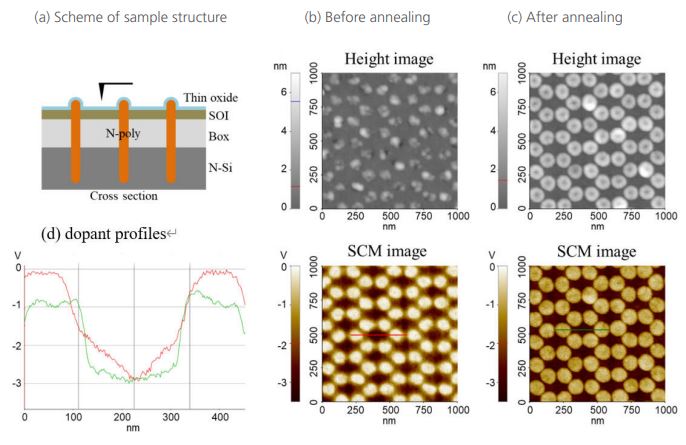Semiconductor devices have revolutionized our modern world, powering everything from computers to smartphones.
Their compact size and remarkable capabilities have made them indispensable components in our everyday lives.
But have you ever wondered how these sophisticated devices work? How can we peek inside to understand how they function at the microscopic level?
Fortunately, scientific advancements have paved the way for technologies like best Scanning Capacitance Microscopy (SCM) that offer a glimpse into the inner workings of semiconductor devices.
That said, let’s dig deep into the world of SCM and explore how it can unlock the mysteries of semiconductor devices. Additionally, we’ll look into the behavior of transistors and investigate the effects of doping, shedding light on this fascinating field of study.
Unraveling Transistor Behavior
Transistors serve as the building blocks of modern electronic circuits, acting as amplifiers and switches. Understanding their behavior is crucial for developing more efficient and powerful devices.
SCM provides a unique perspective by allowing scientists to observe the dynamic changes in capacitance as voltage is applied to the transistor.
As voltage is increased, the SCM tip scans the surface of the device, collecting capacitance data.
This data reveals crucial information about the charge distribution within the device, aiding in the understanding of transistor functionality.
By analyzing the capacitance variations, researchers can identify the presence of defects, quantify carrier concentrations, and even visualize charge trapping phenomena.
For instance, imagine a scenario where a transistor’s performance is subpar. Through SCM analysis, scientists can pinpoint potential areas of concern, such as elevated surface charge or localized charge traps. This information can guide engineers in refining the device’s design, optimizing its performance, and reducing failure rates.
Investigating Doping Effects
Doping, the intentional introduction of impurities into semiconductor materials, plays a pivotal role in tailoring the properties of devices.
However, the impact of doping on device performance is highly complex and often difficult to ascertain.
SCM serves as an invaluable tool for probing the effects of doping and shedding light on the intricate interplay between dopants and carriers.
By utilizing SCM, scientists can precisely map the carrier concentration variations resulting from specific doping profiles.
This data allows for a detailed examination of the dopant diffusion, interface charge distributions, and even junction depth.
Such insights are vital in optimizing semiconductor fabrication processes and promoting the development of more efficient devices.
For example, let’s consider a scenario where a semiconductor material has undergone the process of ion implantation for doping purposes.
SCM can reveal the resulting carrier profiles, enabling researchers to evaluate the success of the implantation process and determine if further refinement is necessary.
The ability to visualize and quantify dopants empowers scientists to troubleshoot and enhance the performance of semiconductor devices.
Semiconductor Devices with Scanning Capacitance Microscopy
Approaching the topic of SCM and semiconductor devices from different viewpoints can provide a well-rounded understanding. Let’s explore a couple of contrasting perspectives:
Enhancing Device Performance
From this viewpoint, SCM is seen as a crucial tool in the quest for optimizing device performance. By studying the behavior of transistors and investigating doping effects at the microscopic level, researchers gain valuable insights that can guide the design and fabrication processes. This perspective emphasizes the practical applications of SCM in developing more efficient and reliable semiconductor devices.
Fundamental Scientific Research
SCM is also of great interest to scientists pursuing fundamental research in the field of semiconductor physics and materials science.
Exploring the mysteries of semiconductor devices through SCM not only helps improve practical applications but also deepens our understanding of the underlying principles governing their behavior.
This perspective highlights the significance of SCM in unraveling the scientific mysteries hidden within semiconductors.
Personal Perspective
As an engineer working in the semiconductor industry, I have had the opportunity to witness the power of SCM firsthand.
One particular project stands out in my memory. We were experiencing performance issues in a newly developed device, and traditional testing methods failed to provide a clear answer.
Turning to Wintech’s Nano SCM, we were able to identify a localized charge trapping phenomenon near the device’s junction, which was responsible for the performance degradation.
Armed with this knowledge, we were able to refine the fabrication process, ultimately improving the device’s performance by over 20%.
Conclusion
Scanning Capacitance Microscopy (SCM) offers a fascinating window into the microscopic world of semiconductor devices.
By analyzing capacitance variations, SCM enables researchers to decipher the behavior of transistors and investigate the effects of doping.
This advanced technique not only contributes to the development of more efficient and reliable devices but also deepens our understanding of the fundamental principles governing their function.




